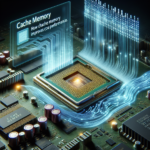How CPUs Handle Multithreading and Its Benefits

Introduction to Multithreading in CPUs
In the realm of modern computing, the efficiency and speed of processing tasks are paramount. One of the key technologies that enable this efficiency is multithreading. Multithreading allows a CPU to execute multiple threads concurrently, significantly enhancing performance and resource utilization. This article delves into how CPUs handle multithreading and the benefits it brings to computing.
Understanding Multithreading
What is a Thread?
A thread is the smallest unit of processing that can be scheduled by an operating system. It is a sequence of programmed instructions that the CPU can execute independently. Threads are a component of a process, which is a running instance of a program. A single process can contain multiple threads, all of which share the same resources but execute independently.
What is Multithreading?
Multithreading is the ability of a CPU to manage multiple threads within a single process. This capability allows for parallel execution of tasks, improving the efficiency and performance of applications. Multithreading can be implemented at both the hardware and software levels, with modern CPUs designed to support this feature natively.
How CPUs Handle Multithreading
Hardware-Level Multithreading
At the hardware level, multithreading is implemented through techniques such as Simultaneous Multithreading (SMT) and Hyper-Threading Technology (HTT). These techniques enable a single physical CPU core to appear as multiple logical cores to the operating system, allowing it to execute multiple threads concurrently.
- Simultaneous Multithreading (SMT): SMT allows multiple threads to be executed simultaneously within a single CPU core. This is achieved by duplicating certain parts of the core, such as the register files and execution units, enabling the core to handle multiple threads at once.
- Hyper-Threading Technology (HTT): Developed by Intel, HTT is a form of SMT that allows a single physical core to appear as two logical cores. This enables the core to execute two threads concurrently, improving overall performance and resource utilization.
Software-Level Multithreading
At the software level, multithreading is managed by the operating system and the application itself. The operating system’s scheduler is responsible for allocating CPU time to different threads, ensuring that each thread gets a fair share of processing power. Applications can be designed to create and manage multiple threads, allowing them to perform tasks in parallel and improve responsiveness.
Benefits of Multithreading
Improved Performance
One of the primary benefits of multithreading is improved performance. By allowing multiple threads to execute concurrently, multithreading enables better utilization of CPU resources. This leads to faster execution of tasks and improved overall system performance.
Enhanced Responsiveness
Multithreading can significantly enhance the responsiveness of applications. By offloading time-consuming tasks to separate threads, the main thread can remain responsive to user input. This is particularly important in interactive applications, such as video games and graphical user interfaces, where responsiveness is critical.
Better Resource Utilization
Multithreading allows for better utilization of CPU resources. By executing multiple threads concurrently, the CPU can make use of idle resources, such as execution units and cache memory, that would otherwise remain unused. This leads to more efficient use of the CPU and improved overall system performance.
Scalability
Multithreading enhances the scalability of applications. As the number of CPU cores increases, applications designed to take advantage of multithreading can scale more effectively, distributing tasks across multiple cores and improving performance. This is particularly important in server environments, where scalability is critical for handling large workloads.
Challenges of Multithreading
Complexity
One of the main challenges of multithreading is the increased complexity of application design. Writing multithreaded code requires careful consideration of synchronization and communication between threads to avoid issues such as race conditions and deadlocks. This can make the development process more complex and error-prone.
Overhead
Multithreading introduces some overhead due to the need for context switching and synchronization between threads. Context switching occurs when the CPU switches from executing one thread to another, which can incur a performance penalty. Additionally, synchronization mechanisms, such as locks and semaphores, can introduce overhead and impact performance.
Debugging and Testing
Debugging and testing multithreaded applications can be more challenging than single-threaded applications. Issues such as race conditions and deadlocks can be difficult to reproduce and diagnose, making the debugging process more complex. Thorough testing is essential to ensure the correctness and reliability of multithreaded applications.
FAQ
What is the difference between multithreading and multiprocessing?
Multithreading involves executing multiple threads within a single process, sharing the same resources. Multiprocessing, on the other hand, involves executing multiple processes, each with its own resources. While both techniques enable parallel execution, multithreading is generally more efficient in terms of resource utilization, while multiprocessing provides better isolation between tasks.
Can all applications benefit from multithreading?
Not all applications can benefit from multithreading. Applications that are inherently sequential or have limited parallelism may not see significant performance improvements from multithreading. However, applications with tasks that can be executed concurrently, such as data processing and simulations, can benefit greatly from multithreading.
How does multithreading impact power consumption?
Multithreading can impact power consumption in different ways. On one hand, it can lead to increased power consumption due to the additional processing activity. On the other hand, by improving efficiency and reducing idle time, multithreading can lead to more efficient use of power. The overall impact on power consumption depends on the specific workload and implementation.
What are some common synchronization mechanisms used in multithreading?
Common synchronization mechanisms used in multithreading include:
- Locks: Used to ensure that only one thread can access a shared resource at a time.
- Semaphores: Used to control access to a shared resource by multiple threads.
- Mutexes: A type of lock that provides mutual exclusion, ensuring that only one thread can access a resource at a time.
- Condition Variables: Used to synchronize threads based on certain conditions.
How do modern operating systems support multithreading?
Modern operating systems support multithreading through their scheduling and process management mechanisms. The operating system’s scheduler allocates CPU time to different threads, ensuring fair distribution of processing power. Additionally, operating systems provide APIs and libraries for creating and managing threads, as well as synchronization mechanisms to coordinate thread execution.
Conclusion
Multithreading is a powerful technology that enables CPUs to execute multiple threads concurrently, improving performance, responsiveness, and resource utilization. By leveraging both hardware and software-level multithreading, modern CPUs can handle complex workloads more efficiently. While multithreading introduces some challenges, such as increased complexity and overhead, the benefits it brings to computing make it an essential feature in today’s processors. As technology continues to evolve, multithreading will remain a critical component in enhancing the performance and scalability of applications.




